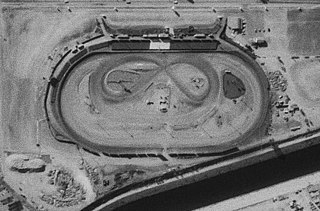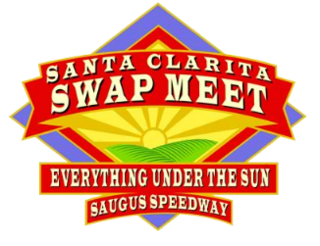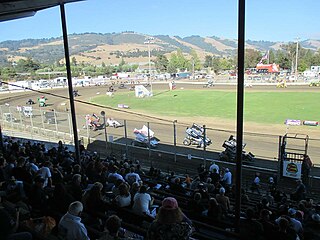Related Research Articles

Midget cars, also speedcars in Australia, is a class of racing cars. The cars are very small with a very high power-to-weight ratio and typically use four cylinder engines. They originated in the United States in the 1930s and are raced on most continents. There is a worldwide tour and national midget tours in the United States, Australia, and New Zealand.

The 39th International 500-Mile Sweepstakes was held at the Indianapolis Motor Speedway on Monday, May 30, 1955. The event was race 1 of 11 of the 1955 AAA National Championship Trail and was race 3 of 7 in the 1955 World Championship of Drivers.
John Ashley Thomson was an American racecar driver. Thomson was nicknamed "the Flying Scot." He won several championships in midgets and sprint cars before competing in Championship Car racing. He won the pole position for the 1959 Indianapolis 500.
Robert Charles Sweikert was an American racing driver, best known as the winner of the 1955 Indianapolis 500 and the 1955 National Championship, as well as the 1955 Midwest Sprint car championship - the only driver in history to sweep all three in a single season.
Ed Elisian was an American racecar driver, mainly competing in the National Championship. He died in a crash at the Milwaukee Mile.
New Hampshire Motor Speedway is a 1.058-mile (1.703 km) oval speedway located in Loudon, New Hampshire, which has hosted NASCAR racing annually since 1990, as well as the longest-running motorcycle race in North America, the Loudon Classic. Nicknamed "The Magic Mile", the speedway is often converted into a 1.600-mile (2.575 km) road course, which includes much of the oval.

Ascot Park, first named Los Angeles Speedway and later New Ascot Stadium, was a dirt racetrack located near Gardena, California. Ascot Park was open between 1957 and 1990. The track held numerous United States Auto Club (USAC) national tour races and three NASCAR Grand National races. The Turkey Night Grand Prix was held at the track for several decades.
This article discusses the year-by-year history of the Indianapolis 500 race.
Joshua C. James "Aggie" Agajanian was an influential Armenian-American figure in American motorsports history. He was a promoter and race car owner.

Seekonk Speedway is a family entertainment venue that features racing of all kinds on a semi-banked 1/3 mile asphalt-paved oval, located on U.S. Route 6 in Seekonk, Massachusetts.

Williams Grove Speedway is a half-mile dirt racing track located in Mechanicsburg, Pennsylvania, United States. The speedway opened on May 21, 1939, it has been owned by the Hughes family for over 50 years and has hosted many of the most notable national touring series and some of those most prestigious races in the country. The speedway is entering its 81st year of operation, with racing every Friday from March to October and other special events. One of these special events is the $75,000 to win National Open for sprint cars sanctioned by the World of Outlaws racing series held in late September or early October each year.
Anthony Peter Willman was an American racecar driver. He was killed in a midget car accident.
Dewey Gatson, better known as Rajo Jack or his pseudonym Jack DeSoto, was an American racecar driver. He is known as one of the first African American racers in America. He won races up and down the West Coast of the United States in stock cars, midgets, big cars and motorcycles. Rajo Jack was inducted in the West Coast Stock Car Hall of Fame in 2003 and the National Sprint Car Hall of Fame in 2007.

Saugus Speedway is a 1/3 mile racetrack in Saugus, Santa Clarita, California on a 35-acre (140,000 m2) site. The track hosted one NASCAR Craftsman Truck Series event in 1995, which was won by Ken Schrader. Schrader became the first NASCAR driver to win in a race in all three of the sanctioning body's major series, following previous wins in the Winston Cup and Busch Grand National Series. The stadium was closed on July 19, 1995 and no longer holds races.
Robert Barkhimer, nicknamed "Barky", was a promoter on the West Coast of the United States. He was born in Berkeley, California. His career started as a midget car racer and ended as a senior vice president at NASCAR.
There has been auto racing in Illinois for almost as long as there have been automobiles. Almost every type of motorsport found in the United States can be found in Illinois. Both modern and historic tracks exist in Illinois, including NASCAR's Chicagoland Speedway and Gateway International Speedway. Notable drivers from Illinois include Danica Patrick, Tony Bettenhausen, and Fred Lorenzen.
Lakewood Speedway was a race track located south of Atlanta, Georgia, in Lakewood, just north of the eastern arm of Langford Parkway. The track held many kinds of races between 1919 and 1979, including events sanctioned by AAA/USAC, IMCA, and NASCAR. It was a one-mile (1.6 km) dirt track which was located adjacent to Lakewood Fairgrounds. Lakewood Speedway was considered the "Indianapolis of the South" as it was located in the largest city in the Southern United States and it held an annual race of the Indy cars.
The Las Vegas Park Speedway was a horse and automobile racing facility in Las Vegas, Nevada. It was built to be a horse racing facility and it held single races in NASCAR Grand National Series, AAA, and USAC Stock cars before it was demolished. It opened as the Las Vegas Jockey Club.

Ocean Speedway, formerly known as Watsonville Speedway, is a dirt oval located in Watsonville, California, United States, at the Santa Cruz County Fairgrounds.
Michael "Buddy" Kofoid is an American professional dirt track and stock car racing driver. He competes full-time in the USAC National Midget Series and POWRi Lucas Oil National Midget Series, driving for Keith Kunz Motorsports. He is the 2021 and 2022 USAC National Midget Series champion. He also competed part-time in the NASCAR Camping World Truck Series, driving the No. 51 Toyota Tundra for Kyle Busch Motorsports, and part-time in the ARCA Menards Series, driving the No. 15 Toyota Camry for Venturini Motorsports. He also has competed with the NOS Energy Drink World of Outlaws Sprint car Series. He collected his first Win at Husets Speedway on June 23rd 2022.
References
- ↑ Tom Mottor, History of the Oakland Speedway, 1931-1941; (Volume 1, Tracks of the West), 2002
- ↑ Where to Go, How to Go, A guide to points of interest in the east shore empire, Key System, Ltd.; Key Terminal Railway, Ltd.; East Bay Street Railways, Ltd.; East Bay Motor Coach Lines, Ltd., ca. 1933 (during San Francisco–Oakland Bay Bridge Construction and after Morcom Rose Garden (1932))
- 1 2 3 4 Lap #1 How Barky Got Started RACING Archived September 29, 2007, at the Wayback Machine , Davis Motorsports, reminiscence by Bob Barkhimer, former race driver and Business Manager for BCRA (Bay Cities Racing Association) and NASCAR co-founder
- ↑ Clyde Rea Bray 1902 - 1941
- ↑ Dorie Sweikert, Along For the Ride-A Love Story, (1998, Nicholas Ward Publishing, LLC.), no longer in print, reprinted under new publisher ca. 2005
- ↑ Motter, Tom, A History of the Oakland Speedway, 1931-1941, 2002, by Vintage Images
- ↑ Magri, Ernest, The Autobiography of Ernie Magri, 1995, self-published
- ↑ Motter, Tom, A History of the Oakland Speedway, 1931-1941, 2002, by Vintage Images
- ↑ Stormwater Guidelines and Requirements, "Did You Know?", City of Emeryville fact box, as retrieved on Aug 7, 2007
- ↑ Tom Mottor, A History of Oakland Stadium 1946-1955, (Volume 2, Tracks of the West)